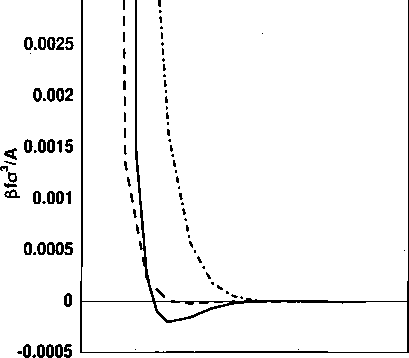0.003

30 35 40 45 50 55 60
H∕σ
Figure 6.12: Interaction force between the two grafted monolayers in the presence of
free polymer as a function of the separation between them for different free polymer chain
lengths: Ny = 50 (dot-dashed curve), Ny = 100 (dashed curve), and Ny = 150 (solid curve).
Other parameter are fixed at Nff = 101, pgσ'g = 0.1, Pf σj = 0.6, and σg = σy = σ.
Pgy∕Ng oc a λ, where λ is the scaling exponent. From modified iSAFT, λ — 2.
As discussed earlier that for a fixed pg, and a, the force is purely repulsive at
higher bulk free polymer densities and attractive at lower densities (see fig. 6.lib).
Hence, the critical values of a increases with the increase in the bulk free polymer
density, as shown in fig. 6.13b. Again, the locus of these values for different bulk free
polymer densities follows the scaling relation: pgVNg oc a~2.
Next we investigate the effect of changing the relative sizes of the segments in
the free and grafted polymers, β = Cf∕σg, on the interaction force between the
grafted monolayers. Figure 6.14a shows the boundaries between purely repulsive
and attractive domains for different values of β, at fixed bulk free polymer density.
The boundaries shift towards the attractive domain or in other words the critical
171
More intriguing information
1. The name is absent2. Education and Development: The Issues and the Evidence
3. Visual Artists Between Cultural Demand and Economic Subsistence. Empirical Findings From Berlin.
4. Reform of the EU Sugar Regime: Impacts on Sugar Production in Ireland
5. The magnitude and Cyclical Behavior of Financial Market Frictions
6. Keystone sector methodology:network analysis comparative study
7. Announcement effects of convertible bond loans versus warrant-bond loans: An empirical analysis for the Dutch market
8. Making International Human Rights Protection More Effective: A Rational-Choice Approach to the Effectiveness of Ius Standi Provisions
9. Fiscal Sustainability Across Government Tiers
10. Partner Selection Criteria in Strategic Alliances When to Ally with Weak Partners